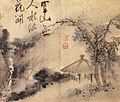Choi Buk
| Choi Buk | |
 | |
| Korean name | |
|---|---|
| Hangul | 최북 |
| Hanja | 崔北 |
| Revised Romanization | Choi Buk |
| McCune–Reischauer | Ch'oe Puk |
| Pen name | |
| Hangul | 호생관, 삼기재, 거기재 |
| Hanja | 毫生館, 三奇齋, 居其齋 |
| Revised Romanization | Hosaenggwan, Samgijae, Geogijae |
| McCune–Reischauer | Hosaenggwan, Samgijae, Kŏgijae |
| Courtesy name | |
| Hangul | 성기, 유용 |
| Hanja | 聖器, 有用 |
| Revised Romanization | Seonggi, Yuyong |
| McCune–Reischauer | Sŏnggi, Yuyong |
Choi Buk (fl. 1755–85), was a Korean painter of the late Joseon period. He used many pen names, Samgijae, Hosaenggwan, Songjae, Giam, Geogijae among them.
Life
His childhood remains unknown, as well as the social status of his family. The Grove says 'floruit c. 1755–85'.[1] Nevertheless, the Korean wiki page ko:최북 says: 최북(崔北, 1712년 – 1760년)은 조선 숙종, 영조 때의 화가이다... and gives a reference to AKS [2]... that explains why 1720 can be guessed as his birth year.
It seems that, despite the fame of Choi Buk in Seoul, his excessive drinking left him perpetually short of cash, and he resorted to making trips to other cities to sell his works. He may have died in Seoul, but the year remains unrecorded.
Style and Gallerie
Choi Buk was acquainted with Kim Hong-do, Kim Deuk-sin, Yi In-mun, but his works are dissimilar to theirs.

The Korean Copyright Commission [3] lists 20 paintings for Choi Buk, while Towooart[4] gives a short notice.
-

Pyohun Temple
금강산 표훈사도 -

Jo-eo Landscape
조어산수 -

Cho-ok Landscape
초옥산수 -

Bull riding
맹우도(려우귀가)
See also
References
Bibliography
- Turner, Jane (2003). Grove Dictionary of Art. Oxford University Press, USA. p. 32600. ISBN 978-0-1951-7068-9.